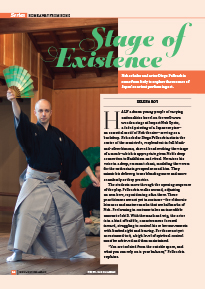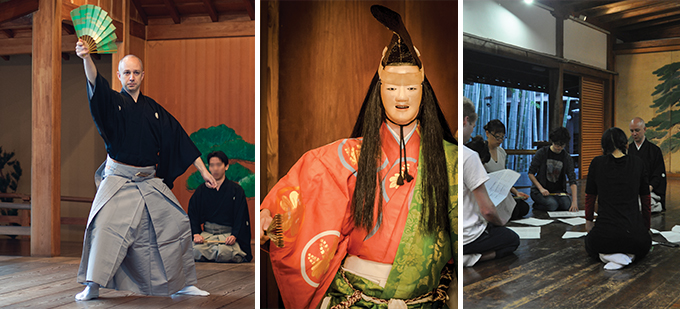Home > Highlighting JAPAN >Highlighting Japan June 2015>Home away from home
Highlighting JAPAN

Home away from home
Diego Pellecchia
Stage of Existence
Noh scholar and actor Diego Pellecchia came from Italy to explore the essence of Japan’s ancient performing art.

Half a dozen young people of varying nationalities kneel on the well-worn wooden stage at Impact Hub Kyoto, a faded painting of a Japanese pine—an essential motif of Noh theater—serving as a backdrop. Noh scholar Diego Pellecchia sits in the center of the semicircle, resplendent in full black-and-silver kimono, shaved head evoking the visage of a monk—which is appropriate given Noh’s deep connection to Buddhism and ritual. He raises his voice in a deep, resonant chant, modeling the verses for the enthusiasts grouped around him. They mimic his delivery, tones blending more and more seamlessly as they practice.
The students move through the opening sequence of the play. Pellecchia walks around, adjusting an arm here, repositioning a fan there. These practitioners are not yet in costume—the elaborate kimonos and austere masks that are hallmarks of Noh. Performing in costume takes an incredible amount of skill. With the mask and wig, the actor is in a kind of bubble, consciousness focused inward, struggling to control his or her movements with limited sight and hearing. For those not yet accustomed to it, a high level of spiritual control must be achieved and then maintained.
“You are isolated from the outside space, and what you can rely on is your balance,” Pellecchia explains.
Pellecchia first took interest in the ancient dramatic art of Noh while living in his hometown of Brescia in northern Italy. He was writing a thesis on Shakespeare, and found the Akira Kurosawa film Throne of Blood, which draws from Macbeth and the stark aesthetics of Noh. He knew nothing about Japanese culture at the time, but the film pulled him in. Doing further research, he learned that a certified instructor in the Kongo school of Noh, Monique Arnaud, had a studio only an hour away in Milan. He went to meet her, began to practice, and soon fell in love with the esoteric Japanese form of theater and the way it made him pay attention to his body.
“It’s meditative,” he says, “and although there are only a few constituent elements, they are very dense and very sophisticated.”
After two years of study with Arnaud, Pellecchia— who had never actually seen Noh performed live—came to Japan to experience the art at its source. In Kyoto, he met Michishige Udaka, a Kongo Noh master and founder of the International Noh Institute (INI) in Kyoto. The visit coincided with Udaka’s sixtieth birthday celebration performance, and Pellecchia appeared in a recital honoring Udaka. Inspired, he decided to pursue a PhD with a focus on Noh. He received his doctorate in 2011 from Royal Holloway, University of London, splitting his research time between the U.K. and Japan.
Pellecchia moved to Kyoto in 2012 to continue his apprenticeship under Udaka. In addition to his lessons with the master a few times a month, he also works hard to spread his love of Noh by disseminating information about what is still a relatively unknown art form, especially outside of Japan. He gives lectures, publishes academic papers, and acts as the INI’s junior director. He also maintains an English-language blog about Noh, and holds workshops such as the one at Impact Hub Kyoto, hoping to spark the kind of interest he felt when he first discovered Noh. He hopes his efforts will help to revitalize the art form.
“It’s important to make an extra effort to have people come, to open doors and open windows,” he says. “Noh has many windows, and some have never been opened, I think. They could be windows facing new gardens, perhaps non-Japanese gardens such as Italian gardens or British gardens. But by doing that, you let the people outside see inside the house, and the people who are already inside the house can see outside.”
The pungency of incense floats atop hints of green tea, old wood, and the fresh scent of bamboo wafting in from the enclosed garden. The students continue on to the dance as Pellecchia demonstrates the delicately nuanced movements. They move in intense concentration to make the slow, sweeping, stately gestures. This is only their second workshop, but already their form is beautiful, and it’s clear they’re absorbed in their practice with undivided minds.
© 2009 Cabinet Office, Government of Japan






